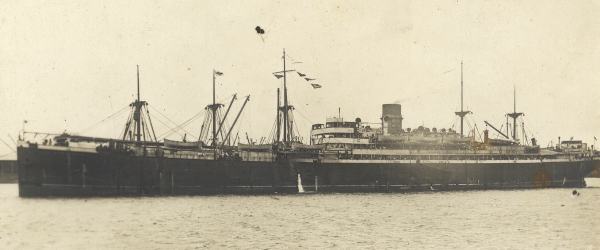Rotorua
British Steam passenger ship

Rotorua under her former name Shropshire. Photo courtesy of State Library of New South Wales
| Name | Rotorua | ||
| Type: | Steam passenger ship | ||
| Tonnage | 10,890 tons | ||
| Completed | 1911 - John Brown & Co Ltd, Clydebank | ||
| Owner | New Zealand Shipping Co Ltd, London | ||
| Homeport | Plymouth | ||
| Date of attack | 11 Dec 1940 | Nationality: | |
| Fate | Sunk by U-96 (Heinrich Lehmann-Willenbrock) | ||
| Position | 58° 56'N, 11° 20'W - Grid AM 2376 | ||
| Complement | 131 (23 dead and 108 survivors). | ||
| Convoy | HX-92 | ||
| Route | Lyttelton, New Zealand - Panama - Halifax (29 Nov) - Barry - Avonmouth | ||
| Cargo | 10,803 tons of general cargo, including refrigerated meat, butter and wool | ||
| History | Completed in September 1911 as Shropshire for Federal Steam Navigation Co Ltd, London. 1917 requisitioned by the Admiralty as troop transport and returned to owner after First World War ended. 1922 renamed Rotorua for New Zealand Shipping Co Ltd, London. In September 1939 again requisitioned by the Admiralty as troop transport but soon thereafter returned to the owner. | ||
| Notes on event | At 15.12 hours on 11 Dec 1940 the Rotorua (Master Edgar Reginald Harrison Kemp) in convoy HX-92 was hit by one G7e torpedo from U-96 while steaming at 9.5 knots about 110 miles northwest of St. Kilda, Outer Hebrides. The ship had been in station #61 as the ship of convoy commodore (Rear-Admiral J.U.P. Fitzgerald, CB, RN) with 20 passengers (service personnel), but convoy had been scattered in a gale on 7/8 December and she was leading a group of about twelve merchant ships without escort when attacked. The lookout in the crow’s nest spotted the torpedo only 100 yards away and tried to telephone the bridge but it struck on starboard side at the forward end of #5 hold before he got through. The explosion shattered the bulkhead to the engine room that was flooded, causing all lights to fail and an immediate list of 15-20° to starboard. The wireless room was completely wrecked, but nevertheless the operator attempted to send a distress signal before the crew, passengers and three gunners (the ship was armed with one 4.7in and one 12pdr gun) began to abandon ship about 10 minutes after being hit. The #2 port boat had been damaged by the gale and #7 starboard boat had its after davit carried away by the explosion, so they launched the remaining six lifeboats but had some difficulties due to moderate sea with a high confused swell that kept crashing the boats against the side of the ship. The Rotorua sank by the stern after about 20 minutes. The master, the commodore, three naval staff members, 14 crew members, one passenger and two gunners were lost. At 15.40 hours, the U-boat surfaced to question the survivors in the boats but had to dive again before they could do so because the Cardita had turned back to come to assistance and opened fire with her stern gun. 15 minutes later U-96 fired one G7e torpedo at the tanker which was missed and managed to escape after laying a smoke screen. During the afternoon the lifeboats were sighted by a Sunderland flying boat that led three armed trawlers to them. The 25 survivors in #5 boat in charge of the fourth officer were picked up by HMS Varanga (FY 1625) (T/Lt G.C. Crowley, RNVR) at 19.40 hours. HMS Alsey (M 51) (T/Lt H.A. Inglis, RNR) then rescued the 34 survivors in #1 and #6 boats at 20.30 hours, while HMS Ebor Wyke (FY 1601) (T/A/Skipper T.E. Olgeirsson, RNR) picked up 49 survivors from #3 and #4 boats, but one of them subsequently died. All survivors were landed at Stornoway in the evening of 12 December. | ||
| On board | We have details of 28 people who were on board. | ||
If you can help us with any additional information on this vessel then please contact us.
